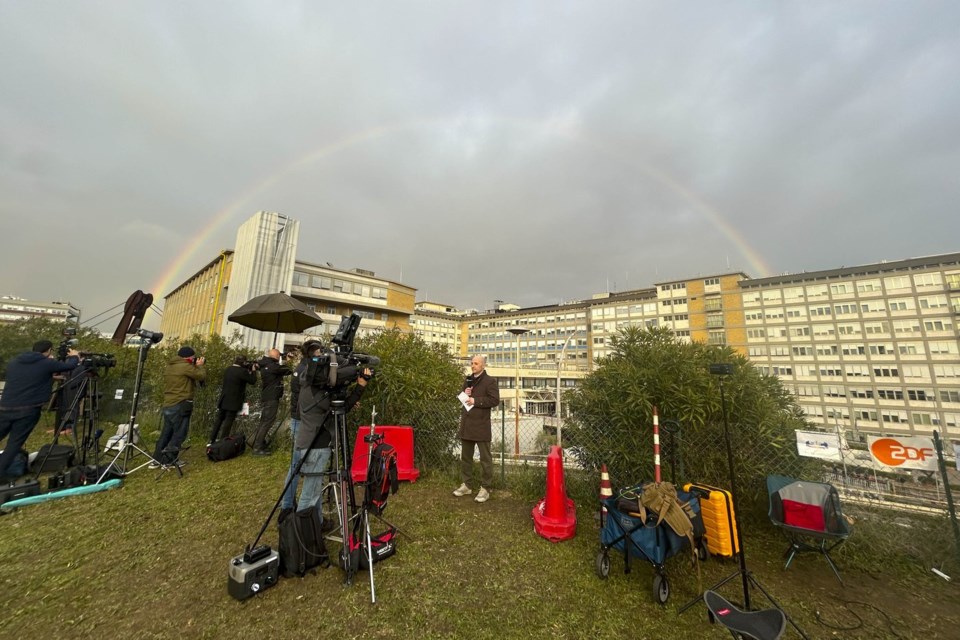ROME (AP) — Pope Francis has developed pneumonia in both lungs, the Vatican said Tuesday, after new tests showed a further complication in the condition of the 88-year-old pontiff that raised concerns about his ability to fight off the infection.
The Vatican said Francis’ respiratory infection also involves asthmatic bronchitis, which requires the use of cortisone antibiotic treatment. “Laboratory tests, chest X-ray, and the Holy Father’s clinical condition continue to present a complex picture,” the Vatican said.
Nevertheless the pope, who had the upper lobe of his right lung removed as a young man, is in good spirits and is grateful for the prayers for his recovery, Vatican spokesman Matteo Bruni said in a late update.
Francis was admitted to Rome’s Gemelli hospital in a “fair” condition on Friday after a weeklong bout of bronchitis worsened. On Monday, medical personnel determined that he was suffering from a polymicrobial respiratory tract infection, meaning a mix of viruses, bacteria and possibly other organisms had colonized in his respiratory tract.
“The follow-up chest CT scan which the Holy Father underwent this afternoon ... demonstrated the onset of bilateral pneumonia, which required additional drug therapy,” Bruni said.
Bronchitis can lead to pneumonia, which is a deeper and far more serious infection of the lungs’ air sacs. Pneumonia can develop in part of one lung or an entire lung or both lungs. It tends to be more serious when both lungs are affected because there isn’t healthy lung tissue to compensate.
Treatment varies by severity but can include providing oxygen through a nasal tube or mask, intravenous fluids – and treatment of the underlying cause of the infection. To date Francis is not known to be using supplemental oxygen, and he has eaten breakfast every day, read the newspapers and done some work from his hospital room.
The Vatican hasn't provided any information about how Francis is responding to any of the drugs he has been given other than to say he isn't running a fever.
Dr. Carmelo D’Asero, an infectious disease and geriatric disease expert in Rome, said Francis' lack of a fever was not necessarily a positive thing, given the seriousness of his infection.
“A high fever is a sign of an immune response to a pathogen,” he said. “Having a low fever and having a serious bronchial infection ... is a sign of a decreased immune response and that makes us worry a little bit more, let’s say. Maybe if he had a fever, it would have been better.”
The Vatican has given no indication of how long the pope might remain hospitalized, only saying that the treatment of such a “complex clinical picture,” which has already required several changes in his drug regimen, would require an “adequate” stay.
Despite the less than positive news about Francis' condition, a rainbow appeared over the Gemelli hospital on Tuesday afternoon and Francis received get-well drawings and cards from children being treated in the hospital's oncology ward.
In a sign that other Vatican business was proceeding as usual Tuesday, the Vatican No. 2, Cardinal Pietro Parolin, continued his delicate visit to Burkina Faso and another top Vatican cardinal, Cardinal Michael Czerny, prepared to leave Wednesday for a five-day visit to Lebanon.
But other business had to be canceled. There will be no weekly general audience Wednesday, and it's not clear if Francis will miss his Sunday noon blessing for a second week in a row. His hospitalization has also forced the cancellation of some events surrounding the Vatican Holy Year, the once-every-quarter-century ceremony in which millions of pilgrims flock to Rome.
This Holy Year weekend was dedicated to deacons, the ministry that is a necessary step for men who are preparing to become priests. Francis had an unrelated audience Saturday and was supposed to have ordained the deacons during a Mass on Sunday. The Vatican on Tuesday announced his audience was canceled and that the archbishop who is organizing the Jubilee would celebrate the Mass in the pope's place.
It’s a similar arrangement that the Vatican announced last weekend when artists in town had to settle for a scrapped papal audience and a cardinal presiding over their special Mass.
The next Jubilee events on the calendar that would typically involve the pope are the March 8-9 weekend dedicated to volunteers.
Francis had part of one lung removed after a pulmonary infection as a young man and is prone to bouts of bronchitis in winter. He has admitted in the past that he is a non-compliant patient, and even his close Vatican aides have said he pushed himself too far even once his bronchitis was diagnosed.
He refused to let up on his busy schedule and ignored medical advice to stay indoors during Rome’s chilly winter, insisting on sitting through an outdoor Jubilee Mass for the armed forces on Feb. 9 even though he was having trouble breathing.
Francis’ hospital admission this year has already sidelined him for longer than a 2023 hospitalization for pneumonia.
___
Visual journalist Paolo Santalucia contributed.
___
Associated Press religion coverage receives support through the AP’s collaboration with The Conversation US, with funding from Lilly Endowment Inc. The AP is solely responsible for this content.
Nicole Winfield, The Associated Press



